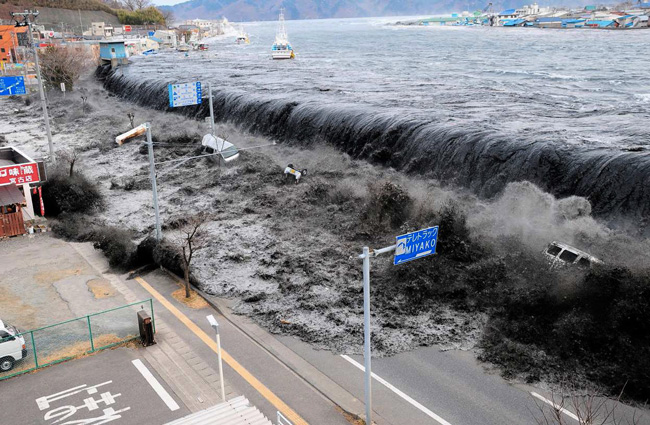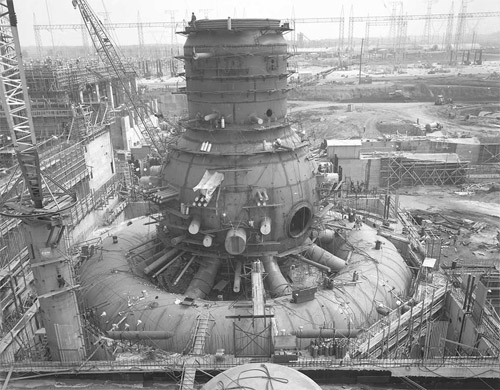Human errors, design flaws and natural cataclysms
A nuclear accident dwarfs all other types of accidents in public opinion. For example, the Tokai-Mura 1999 accident occurred at the same time than an explosion in a Ukrainian coal mine. The tragic deaths of the 80 Ukrainian miners went unnoticed, while the circumstances of the Japanese accident were widely covered. More recently, the 2011 Fukushima nuclear accident does not appear to have caused any casualties up to now, but it has scared the public much more than the 30,000 dead or drowned caused the Japanese tsunami.
The idea is well rooted in the public mind that reactors are potential atomic bombs, reactor accidents a kind of nuclear explosion. Wrongly, because if a very serious accident can result from an explosive uncontrolled chain reaction, the phenomena which lead to the dissemination of radioactive materials are not nuclear: they are fires, chemical explosions or loss of cooling.
The distinction may look academic, but a reactor accident, even a very serious one, cannot lead to a nuclear explosion. The reactor architecture, its « geometry », in particular the distance between the fuel elements, were designed so that the number of neutrons could not explode. Any serious disorder that occurs in the core: vaporization of water, fuel fusion, is strongly anti-reactive, that is to say that after a brief power surge, which can be strong, the chain reaction stops by itself.

The nuclear risk and cataclysms
The accident at the Fukushima Daïchi power plant was the result of a cataclysm, the tsunami that struck Japan on March 11, 2011. If the reactors located by the sea withstood the violent earthquake that preceded it, the protections proved to be very insufficient for the tidal wave. The 14 m monstrous wave had only a 6 m high protective seawall in front of it! The buildings were flooded, the electricity was cut and the emergency equipment put out of service. This generated major cooling problems which were the source of a cascade of events, loss of reactors and radioactive releases.
© DR
Moreover, automatisms are implemented to shut down the reactor immediately in case of emergency by stopping the fission reactions. These automatisms, which are necessary because of the react within a very short time, have proven to be effective. In the Chernobyl case, they had been deactivated for an experiment.
There was no nuclear explosion during this accident but an uncontrolled surge of power which led to the fragmentation of the fuel rods under the effect of heat. This fragmentation caused an explosion of the uranium oxide pellets in contact with water followed by a second explosion due to the release of hydrogen. This raised the upper slab of the reactor. Then the radioactive graphite which served as a moderator caught fire.
At Three Mile Island, a core melting occured due to a loss of cooling, but the radioactivity remained confined. But it was the fear of an explosion due to the presence of hydrogen in the containment building that led to a population evacuation
But shutting down the reactor is not enough, since the reactor core continues to release a lot of heat due to radioactive decay. It is necessary to insure a very strong cooling. The more recent and serious Fukushima accident is also due to a loss of cooling. This loss lasted several hours. It was caused by a cataclysm, the tsunami that struck Japan on March 11, 2011.

Containment building
The picture shows the containment building of one of the Fukushima reactors at the time of its construction. The reactor vessel with the nuclear fuel are inside. Below, one see the decompression toroid (called wet well) that collect the vapor emissions in the event of overpressure. This vapor is normally not radioactive, but can become radioactive if the nuclear fuel cladding melts when cooling is lacking. During the Fukushima accident, most of radioactive material remained in the tank and the enclosure with the exception of fisson products.
© DR
The containment chambers of reactors are designed to confine radioactivity in the event of a core meltdown, the most serious accident that leads to the loss of the reactor. Chernobyl RBMK reactors lacked such containment. The containment building played its role perfectly at Three Mile Island. Those at Fukushima played their role partially, letting volatile radioactive products escape into the atmosphere.
There are also accidents attributed to nuclear power that are not. In 2004, four technicians were fatally burned by a jet of steam at a Japanese power station. The operating company was accused of not having checked the condition of its pipes. However, the jet of steam was not radioactive and the accident could have occurred in another industry.
Other articles on the subject « Nuclear Accidents »
The INES scale
The severity scale of nuclear accidents Nuclear installations and their operation are complex and[...]
Accidents of radioactivity
The importance of a close monitoring of radioactive sources… In many countries, the possess[...]
Mayak Accident
A military long-hidden nuclear accident of the Soviet era Long before Chernobyl, it was suspected[...]
Windscale Accident
Windscale : an accident of the U.K nuclear weapon program (1957) The fire which occurred the 10th[...]
Three Mile Island
1979: A major accident that led to the destruction of a reactor The Three Mile Island plant (TMI)[...]
Tokaimura Accident
1999 : a « criticity » accident in Japan This surprising accident of « criticality » came about i[...]